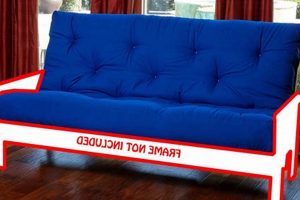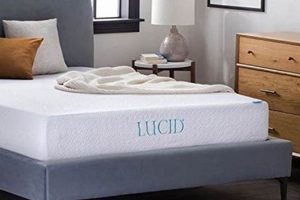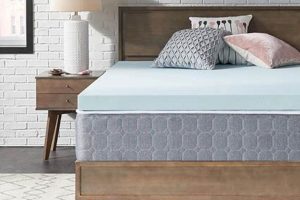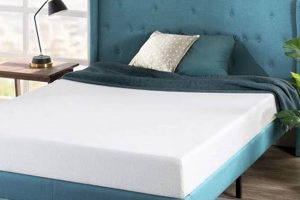The maintenance procedure focuses on removing dirt, allergens, and stains from a specific type of bedding designed for comfort and support. Regular upkeep enhances the lifespan and hygiene of the item. For instance, vacuuming the surface can eliminate dust mites and surface debris.
Proper maintenance is crucial for preserving the item’s structural integrity and preventing the buildup of unhealthy microorganisms. Historically, methods have evolved from simple airing and beating to the utilization of specialized cleaning solutions and equipment, reflecting an increased awareness of indoor air quality and health concerns.
The following sections will detail specific methods, recommended products, and preventative measures to ensure the sustained cleanliness and longevity of this bedding component.
Guidance on Upkeep
The following recommendations aim to provide clarity on maintaining the cleanliness of the aforementioned item, thereby extending its usability and promoting a healthier sleeping environment.
Tip 1: Vacuum Regularly: Employ a vacuum cleaner with an upholstery attachment to remove surface dust and debris. Consistent vacuuming, ideally weekly, prevents the accumulation of allergens.
Tip 2: Address Spills Immediately: Prompt action is critical. Blot spills with a clean, dry cloth, working from the outside inward to prevent spreading. Avoid rubbing, as this can embed the stain further into the material.
Tip 3: Utilize Baking Soda for Odor Neutralization: Sprinkle a thin layer of baking soda over the surface and allow it to sit for several hours, preferably overnight. Vacuum thoroughly to remove the baking soda, which will absorb odors.
Tip 4: Spot Clean with a Mild Solution: Combine a small amount of mild detergent with water. Lightly dampen a cloth with the solution and gently blot the affected area. Follow with a clean, damp cloth to remove any residue.
Tip 5: Ensure Thorough Drying: Proper drying is essential to prevent mold and mildew growth. Use fans or a dehumidifier to accelerate the drying process after cleaning. Avoid placing the item in direct sunlight, which can damage the foam.
Tip 6: Employ a Mattress Protector: A high-quality mattress protector acts as a barrier against spills, stains, and allergens, significantly reducing the need for frequent comprehensive upkeep.
Tip 7: Rotate Periodically: Rotating the item regularly, typically every few months, promotes even wear and tear and extends its lifespan.
Adherence to these guidelines will contribute to a cleaner, more hygienic sleeping surface and optimize the lifespan of the bedding.
The subsequent section will explore more intensive upkeep procedures for dealing with persistent stains and odors.
1. Regular Vacuuming
Consistent vacuuming is a foundational element in the effective upkeep of memory foam mattresses. This routine practice directly impacts the removal of surface-level contaminants and contributes significantly to overall hygiene.
- Dust Mite Mitigation
Vacuuming effectively extracts dust mites, microscopic organisms that thrive in bedding and contribute to allergic reactions. The consistent removal of these allergens creates a healthier sleeping environment and reduces respiratory irritation.
- Surface Debris Removal
Daily shedding of skin cells, hair, and other particulate matter accumulates on the mattress surface. Vacuuming removes this debris, preventing it from embedding deeper within the foam structure and potentially attracting pests or fostering bacterial growth.
- Improved Air Quality
The accumulation of dust and allergens on a mattress can negatively impact indoor air quality. Regular vacuuming minimizes the release of these irritants into the air, contributing to a cleaner and healthier home environment.
- Enhanced Mattress Longevity
By preventing the deep accumulation of dirt and debris, vacuuming helps maintain the structural integrity of the memory foam. This proactive approach contributes to a longer lifespan for the mattress and preserves its comfort and support characteristics.
These aspects underscore the importance of regular vacuuming as a primary maintenance procedure. Consistent application of this simple task directly supports the prolonged cleanliness and hygiene of memory foam mattresses, enhancing the overall user experience.
2. Prompt Stain Removal
The immediate addressing of stains on memory foam mattresses is critical in minimizing permanent damage and simplifying the overall cleaning process. Delayed action can lead to irreversible discoloration and necessitate more intensive, potentially damaging, cleaning procedures.
- Prevention of Deep Penetration
Memory foam is porous, allowing liquids to seep quickly into its structure. Prompt removal minimizes the depth to which a stain permeates, reducing the area that requires treatment and preventing the stain from bonding permanently with the foam fibers. For instance, quickly blotting a spilled beverage prevents it from soaking deep into the mattress, making it easier to remove.
- Mitigation of Odor Development
Unattended stains, particularly those from organic sources like bodily fluids, can foster bacterial growth, leading to unpleasant odors. Addressing the stain promptly eliminates the source of bacterial proliferation, thereby preventing persistent and difficult-to-remove smells. An example is the immediate cleaning of urine stains, which can develop into a strong, lingering odor if left untreated.
- Simplification of Cleaning Procedures
Fresh stains are generally easier to remove than those that have set over time. Prompt action often requires only mild cleaning solutions and gentle blotting, reducing the need for harsh chemicals or abrasive scrubbing, which can damage the memory foam. For example, a fresh blood stain can often be removed with cold water and mild soap if addressed immediately, whereas an older stain may require enzymatic cleaners.
- Preservation of Mattress Integrity
Aggressive cleaning methods, frequently required for set-in stains, can compromise the structural integrity of the memory foam, potentially affecting its support and comfort. Addressing stains promptly reduces the need for such harsh treatments, preserving the mattress’s original properties. For instance, avoiding vigorous scrubbing on a fresh stain prevents the foam from tearing or losing its shape.
These considerations demonstrate that immediate intervention in the event of a stain is crucial for maintaining the cleanliness and longevity of memory foam mattresses. Delaying action c
an lead to more complex cleaning challenges and potentially compromise the integrity of the sleeping surface.
3. Odor Neutralization
Odor neutralization constitutes a crucial element in the comprehensive maintenance of memory foam mattresses. Unlike simply masking odors, neutralization targets and eliminates the underlying sources, contributing significantly to a cleaner and more hygienic sleeping environment.
- Baking Soda Absorption
Sodium bicarbonate, commonly known as baking soda, possesses amphoteric properties, enabling it to react with both acidic and alkaline odor molecules. When applied to a mattress, baking soda adsorbs these molecules, effectively neutralizing odors from spills, bodily fluids, or general environmental contaminants. This process differs from merely covering up the smell, instead removing the odor-causing compounds.
- Activated Charcoal Filtration
Activated charcoal, a form of carbon processed to increase its surface area, acts as a potent odor absorbent. Its porous structure traps volatile organic compounds (VOCs) responsible for many mattress odors. While not typically applied directly, activated charcoal filters in vacuum cleaners or air purifiers used in the bedroom environment can assist in reducing ambient odors absorbed by the mattress over time.
- Enzyme-Based Cleaners
Enzymatic cleaners utilize specific enzymes to break down organic matter, such as urine, sweat, or blood, which are common sources of mattress odors. These enzymes catalyze the decomposition of complex molecules into simpler, odorless compounds. This method is particularly effective for eliminating deeply embedded odors that baking soda or charcoal may not fully address.
- UV-C Light Sanitization
Ultraviolet-C (UV-C) light can be employed to eliminate odor-causing bacteria and fungi on the mattress surface. While not a direct odor neutralizer, UV-C light sanitizes the mattress by killing microorganisms that contribute to unpleasant smells. This method complements other odor neutralization techniques, such as baking soda application or enzymatic cleaning, by addressing the biological sources of odors.
The integration of these odor neutralization strategies within a comprehensive cleaning protocol ensures not only a fresh-smelling mattress but also a reduction in odor-causing agents, fostering a healthier and more comfortable sleep environment. Their application significantly enhances the overall effectiveness of maintaining memory foam mattresses, addressing a key element often overlooked in standard cleaning practices.
4. Proper Drying
Adequate desiccation following any cleaning procedure is paramount in maintaining the integrity and hygiene of memory foam mattresses. Residual moisture fosters an environment conducive to microbial proliferation, undermining the benefits of the cleaning process itself.
- Prevention of Mold and Mildew Growth
Memory foam’s porous structure readily retains moisture. Damp conditions encourage the growth of mold and mildew, leading to unpleasant odors, potential allergic reactions, and degradation of the foam. Thorough drying inhibits these microorganisms, safeguarding the mattress’s hygienic qualities. For example, allowing a mattress to air dry completely after spot cleaning prevents the development of musty smells and visible mold spots.
- Maintenance of Foam Integrity
Prolonged exposure to moisture can compromise the structural integrity of memory foam. Excessive dampness can lead to the breakdown of the foam’s cellular structure, resulting in a loss of support and comfort. Proper drying ensures the foam retains its elasticity and resilience. Leaving a mattress damp after a deep clean, for instance, can cause it to become permanently compressed in certain areas.
- Odor Control
Residual moisture often traps and amplifies odors, negating the efforts made during the cleaning process. Complete drying eliminates this source of unpleasant smells, leaving the mattress fresh and hygienic. Failing to dry a mattress thoroughly after cleaning up a pet accident, for example, can result in lingering odors that are difficult to remove.
- Prevention of Allergen Proliferation
Damp environments are ideal breeding grounds for dust mites and other allergens. Thorough drying minimizes the presence of moisture, thereby inhibiting the proliferation of these allergens and contributing to a healthier sleeping environment. For instance, ensuring a mattress is completely dry after steam cleaning reduces the risk of increased dust mite activity.
These considerations underscore the importance of complete desiccation as a vital step in mattress maintenance. Neglecting this aspect can negate the benefits of the cleaning process, leading to hygienic issues and compromising the mattress’s lifespan. Adequate drying methods, such as using fans or dehumidifiers, should be employed to ensure thorough moisture removal.
5. Preventative Protection
Preventative measures significantly reduce the need for comprehensive cleaning interventions. The application of barriers and proactive strategies inherently minimizes the ingress of contaminants and the accumulation of conditions that necessitate intensive upkeep. For instance, a mattress protector forms a physical shield against spills, bodily fluids, dust mites, and allergens, thereby minimizing direct contact between these substances and the foam core. This initial barrier greatly curtails the frequency and intensity of cleaning requirements, preserving the integrity and hygiene of the mattress over extended periods. The utilization of fitted sheets provides a secondary layer of protection, further reducing the direct exposure of the mattress surface to potential staining agents and surface debris.
Effective preventative protocols also encompass regular maintenance routines aimed at controlling humidity and airflow. Maintaining a stable indoor environment, characterized by appropriate humidity levels, inhibits the growth of mold and mildew within the mattress structure. Employing a bed frame that promotes adequate ventilation beneath the mattress facilitates air circulation, aiding in the dissipation of moisture that may accumulate from perspiration. Furthermore, avoiding activities such as eating or applying lotions directly on the mattress reduces the potential for staining and contamination. By proactively managing these factors, the reliance on aggressive cleaning methods is minimized, extending the lifespan of the mattress and maintaining its hygienic condition.
In summation, preventative protection constitutes an integral component of a comprehensive mattress care strategy. By minimizing the initial exposure to contaminants and fostering an environment less conducive to microbial growth, preventative measures significantly reduce the need for rigorous cleaning interventions. This approach not only simplifies upkeep but also preserves the integrity and longevity of the mattress, ensuring a healthier and more comfortable sleeping environment. The
understanding and implementation of preventative strategies are therefore crucial for effective mattress maintenance.
Frequently Asked Questions
The following questions address common concerns regarding the proper upkeep of memory foam mattresses, providing clarity on best practices and potential pitfalls.
Question 1: How frequently should a memory foam mattress undergo vacuuming?
A vacuuming schedule of once per week is recommended to effectively remove dust mites, allergens, and surface debris. Increased frequency may be warranted in households with pets or individuals with allergies.
Question 2: What is the recommended approach for addressing liquid spills on a memory foam mattress?
Immediate action is crucial. The affected area should be blotted gently with a clean, dry cloth, working from the outside inward to prevent spreading. Rubbing is to be avoided, as it may force the liquid deeper into the foam.
Question 3: Is steam cleaning a suitable method for cleaning a memory foam mattress?
Steam cleaning is generally not recommended. The high heat and moisture levels can damage the memory foam and create an environment conducive to mold and mildew growth.
Question 4: What type of cleaning solutions are considered safe for use on a memory foam mattress?
Mild detergents diluted with water are generally safe. Harsh chemicals, bleach, and abrasive cleaners should be avoided, as they can damage the foam and potentially release harmful fumes.
Question 5: How can odors be effectively eliminated from a memory foam mattress?
Baking soda is a proven odor neutralizer. A thin layer should be sprinkled over the surface, allowed to sit for several hours (preferably overnight), and then thoroughly vacuumed off.
Question 6: What steps should be taken to ensure a memory foam mattress is thoroughly dry after cleaning?
Adequate ventilation is essential. Fans or a dehumidifier can be used to accelerate the drying process. Direct sunlight should be avoided, as it can damage the foam.
Adherence to these guidelines contributes significantly to maintaining the cleanliness, hygiene, and longevity of a memory foam mattress.
The subsequent section will provide a summary of key points and actionable recommendations for effective mattress upkeep.
Conclusion
The preceding discussion has underscored the critical facets of cleaning memory foam mattresses. Emphasis was placed on regular vacuuming, prompt stain removal, odor neutralization, proper drying techniques, and the implementation of preventative protective measures. Each of these procedures contributes uniquely to the maintenance of mattress hygiene, longevity, and overall user satisfaction.
The proactive application of the guidelines outlined herein represents a commitment to ensuring a healthier and more comfortable sleep environment. Sustained adherence to these practices mitigates the risk of allergen accumulation, microbial proliferation, and premature degradation of the mattress material. Consequently, consistent and informed mattress care is an investment in both personal well-being and the long-term value of the bedding investment.







